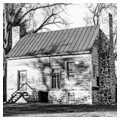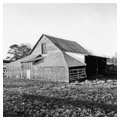You are here
Batte House (The Old Place)
On a hill above low-lying ponds, the Batte House is one of the few early-nineteenth-century houses to survive in this section of Southside. Referred to in family documents as the Old Place, it is a small, hall-parlor frame house built in two stages. The sturdy one-and-a-half-story weatherboarded dwelling was constructed for Alexander W. Batte, a large (but apparently not ostentatious) landowner. This earliest section is set above a high cellar containing the service area. The one-room attic would then have been the bedroom. A few years later, a similar but slightly smaller extension was added. The house, on field-stone foundations that have been reworked in recent years, has massive double-shouldered, exterior-end stone chimneys. To the right of the house is an early-nineteenth-century barn with a loft gable roof rising above the lower hipped roof with its own centered shed-roof projections. Most of the barn's original beaded siding is still in place. In 1881, the farm was sold to Alexander Rae, one of the many Scots who settled in the northwestern section of Greensville County. They were part of a wave of foreign settlers brought into Virginia by the state's immigration officials who hoped to solve the post-Civil War labor shortage created by Emancipation.
Writing Credits
If SAH Archipedia has been useful to you, please consider supporting it.
SAH Archipedia tells the story of the United States through its buildings, landscapes, and cities. This freely available resource empowers the public with authoritative knowledge that deepens their understanding and appreciation of the built environment. But the Society of Architectural Historians, which created SAH Archipedia with University of Virginia Press, needs your support to maintain the high-caliber research, writing, photography, cartography, editing, design, and programming that make SAH Archipedia a trusted online resource available to all who value the history of place, heritage tourism, and learning.

















